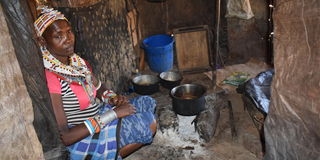Drought deteriorates food consumption index in Samburu

A Samburu woman in her house (manyatta) at Laresoro area in Samburu East. Extreme drought has ravaged the region.
The prolonged drought situation in Samburu has deteriorated household food consumption scores across the livelihood zones, the National Drought Management Authority (NDMA) has said.
Food consumption score is a composite unit based on dietary diversity, food frequency and relative nutrition importance of different food groups based on a seven-day recall of food consumed at household level.
The dietary impacts of drought in a traditional pastoralist economy is being felt amid disruption of normal nomadic grazing patterns for close to three years.
Poor consumption score implies that households are not consuming staples and vegetables everyday and never or very seldom are consuming protein rich food such as meat and dairy.
The NDMA report said the proportion of households with borderline food consumption is 39 percent in pastoral livelihood zones and 88.9 percent in agro pastoral zones.
"The worsening drought situation has occasioned inadequate access to sufficient amounts of safe and nutritious food for normal growth and development. This has indicated the deterioration in household food consumption scores across the livelihood zones," said NDMA in a report.
At the same time, the proportion of children under the age of five years at risk of malnutrition remained high at 25.8 percent compared to 28.9 percent last in the month of October.
However, NDMA said the malnutrition rates are above the World Health Organization (WHO) recommended thresholds driven by lack of milk at household level, poor dietary diversity, inadequate food intake and poor maternal practices such poor breastfeeding practices.
According to NDMA, in the period under study, most households reported taking 1 - 2 meals per day instead of the normal 2- 3 meals a day comprising of cereals, vegetables, milk and oil.
The agency also reported that a shortage of milk caused by drought has pushed up the retail price of the commodity in parts of Samburu. NDMA said that prices are above normal with a litre of cow milk retailing at Sh80 - 100 instead of normally Sh50 - 60 per litre. Camel milk is sold at Sh120 - 150 per litre as opposed to normally Sh 80 - 100.
"A shortage of milk caused by drought has pushed up the retail price of the commodity in a major blow to consumers who are grappling with the high cost of other basic goods," said the report.
Pastoralists are forced to sell their emaciated animals at throwaway prices, or risk losing them altogether to the severe famine. The drought, which officials have termed as the worst in four decades, has threatened the livelihoods of nomadic pastoralists with massive livestock deaths amid lack of water and pastures. The vast arid land is enduring one of their harshest droughts and locals have been pushed into crisis.
The value of livestock which is pastoralists' main livelihood has deteriorated and livestock markets collapsed leading to shortage of milk production.





